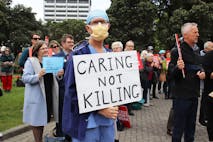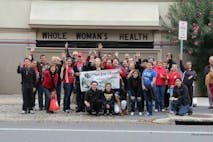
New Archbishop of Canterbury warns of danger in legalizing assisted suicide
Nancy Flanders
·
Opinion·By Catherine Livingston, PhD
Abortion access in America: How the abortion industry demands special treatment
In a column Friday, the Guttmacher Institute writes lamenting of the great distances women have to travel to obtain an abortion, noting one-third of women have to travel more than 25 miles for this elective surgery. Reading this is a little like reading about how a rich kid had to get a used Honda instead of a new Mercedes.
The story says:
In 2008, American women traveled an average of 30 miles to access abortion services, according to “How Far Did U.S. Women Travel for Abortion Services in 2008?” by Rachel and Jenna Jerman of the Guttmacher Institute. Sixty-seven percent of abortion patients traveled less than 25 miles, 16% traveled 25–49 miles, 11% traveled 50–100 miles and 6% traveled more than 100 miles.
I don’t live in a rural area, but I do live in an area with some limited services. As a matter a fact, I drive twice the average the article notes simply to do good grocery shopping, since I am a foodie and most of what is local to me is for basic staples.
Okay, you argue, you don’t have to have the fancy groceries to eat well. And while I might argue back, neither do you have to have an abortion when adoption exists, I will give you that one and tell you about my tooth—which does need surgery.
It’s infected. Bad. The dentist says if it spreads before it’s treated it could threaten my life. I was in the middle of months of travel and moving when this was coming to a head. Finally settled, I called both endodontists and oral surgeons. A regular dentist can no longer treat me. There were limited providers in my area, and none of them knew me well enough to hustle me in, since I was not an existing patient. I have insurance, and yet they would not see me without waiting close to a month (longer than my dentist had said my health could stand without treatment). And when they did have an appointment, insurance or not, they would require me to pay the full price up front for the consult and any immediate work—one place quoted me $300 cash—without any permanent treatment—about the price of an abortion, for the record. They didn’t care about my insurance and said I could submit my papers for reimbursement.
In the end I drove three hours to a major metropolitan area where my old dentist is located—that’s three hours one way—to get a new X-ray and more antibiotics, and be sure I wasn’t in too much danger. Then I got a referral from him for an oral surgeon there in his city—who had an opening in late August, which is my next appointment.
And as I read the Guttmacher piece this morning, all I could think was “seriously? Do you not know that this is the way health care works for every human being sometimes?” I mean, I am standing there telling oral surgeons I cannot wait until September because my infection is at risk of spreading—and I have insurance that is supposed to pay for the consult, by golly; can’t they at least file it? Nope. Office policy. But they have a special credit card I can apply for with a 26% interest rate if I don’t want to pay it up front until the insurance kicks in.
I did find one who would do a “patch job surgery”; the surgeon was over 3 hours from my home and when they checked my benefits, they found I would have to pay out of pocket, all before the procedure, $1100 of a $1500 procedure.
My example is only mine, but it’s not that uncommon. The Guttmacher piece cries foul that:
Women who live in rural areas have to travel greater distances for many services, including primary care and even groceries. It is therefore not surprising that 31% of women who lived in rural areas traveled more than 100 miles to access abortion services, and an additional 43% traveled between 50–100 miles. Rural women are underrepresented among abortion patients.
At least there is truth there. According to one study in the Western Journal of Medicine, “Many rural Americans have limited access to health care…. About 20% of the US population—more than 50 million people—live in rural areas, but only 9% of the nation’s physicians practice in rural communities.”
The University of Missouri medical school has instituted a program to help deal with this national crisis. A story last month about its Pipeline program to place more rural physicians says:
“The national physician shortage is growing worse, and that trend becomes more severe when you consider the maldistribution of physicians in rural areas compared to urban areas,” said Kathleen Quinn, PhD, lead author of the article and director of MU’s Rural Track Pipeline Program. “Our physician workforce will need to be reshaped to address this inequity because research shows only 3 percent of medical school matriculants plan to practice in a rural area.”
It’s troubling that the abortion industry cries foul repeatedly about abortion access when some Americans have trouble finding access to treat actual diseases. That a journal article would even need to be written about such fringe data is telling of its campaign to increase abortion.
Abortion is not a disease. It’s a choice. It is the only surgery that exists where a random surgeon will perform a life-altering operation on a woman in a non-emergency situation without knowing her, her history, her certainty of the procedure or any other medical background.
I recall elective surgery I had for a uterine problem (a real problem, not a baby). It was relatively minor surgery which would not kill anyone, or risk my own life outside natural surgery risks that happen by nature of the fact its surgery. It took me a month to even get scheduled. I had to have pre-surgery mandatory counseling, simply because it’s surgery, to be sure I knew what I was doing and what I wanted.
But Guttmacher’s Rachel Jones, lead author of the article, insists this is burdensome if one wants an abortion:
Many women travel substantial distances to access abortion services. This can present a barrier, particularly for poor and low-income women, who make up the majority of women seeking abortions, and for women in rural areas…. For women in states with mandatory counseling and waiting periods, the barrier is even greater, and one some women may not be able to overcome.
I am a healthy woman for the most part, but the few times I have needed procedures, they have been drawn out and involved travel of 1-3 hours. This is often normal. Should it be? Maybe not, but it is. The abortion industry’s lamenting over having to drive 25 miles to kill a baby is a pitiful statement of its values. Not only do they want abortion to be legal, but they want it to be on every corner, without waiting and paid for with someone else’s taxes.
If we would take a step back and look at what we’re asking for as a nation, we would be like the people who saw the emperor without clothes. The demands of the abortion industry are medically ludicrous, practically unrealistic, and, quite frankly, discriminatory to all the Americans with real diseases who actually do need a clinic near them to save their life, not take someone else’s.
Live Action News is pro-life news and commentary from a pro-life perspective.
Contact editor@liveaction.org for questions, corrections, or if you are seeking permission to reprint any Live Action News content.
Guest Articles: To submit a guest article to Live Action News, email editor@liveaction.org with an attached Word document of 800-1000 words. Please also attach any photos relevant to your submission if applicable. If your submission is accepted for publication, you will be notified within three weeks. Guest articles are not compensated (see our Open License Agreement). Thank you for your interest in Live Action News!

Nancy Flanders
·
Opinion
Angeline Tan
·
Issues
Angeline Tan
·
Guest Column
Emily Berning
·
Opinion
Nancy Flanders
·
Opinion
Mark Wiltz
·
Human Interest
Catherine Livingston, PhD
·
International
Catherine Livingston, PhD
·
Newsbreak
Catherine Livingston, PhD
·
Human Interest
Catherine Livingston, PhD
·
Human Interest
Catherine Livingston, PhD
·